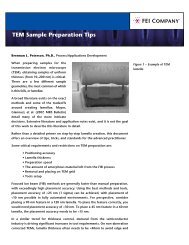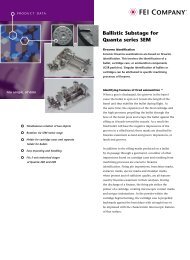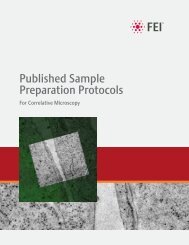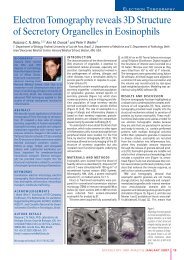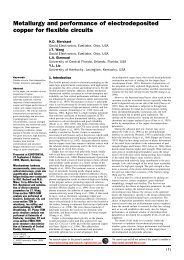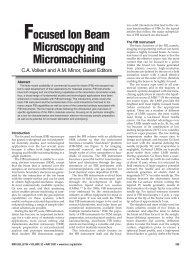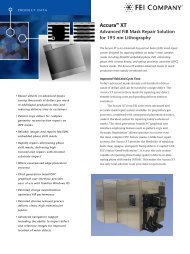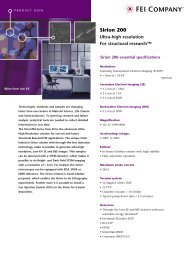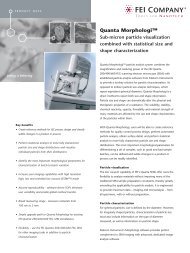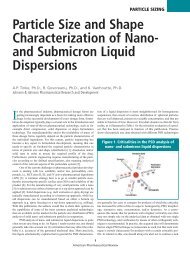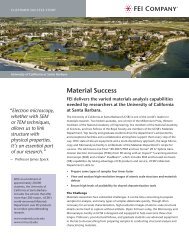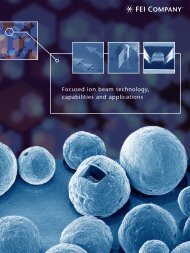Wet STEM: A newdevelopment in environmental SEM for imaging ...
Wet STEM: A newdevelopment in environmental SEM for imaging ...
Wet STEM: A newdevelopment in environmental SEM for imaging ...
You also want an ePaper? Increase the reach of your titles
YUMPU automatically turns print PDFs into web optimized ePapers that Google loves.
contrasted images can be obta<strong>in</strong>ed. Consequently,<br />
all the E<strong>SEM</strong> micrographs presented <strong>in</strong> the<br />
follow<strong>in</strong>g have been obta<strong>in</strong>ed <strong>in</strong> annular darkfield<br />
conditions. The second advantage of this<br />
disposition, us<strong>in</strong>g the sum signal, is that imag<strong>in</strong>g<br />
conditions are not l<strong>in</strong>ked to the area of the sample<br />
imaged.<br />
Moreover, <strong>in</strong> our experimental setup, the<br />
distance between the sample and the detector has<br />
been <strong>in</strong>vestigated <strong>in</strong> order to optimize the contrast.<br />
Best results are obta<strong>in</strong>ed with a distance of about<br />
7 mm, correspond<strong>in</strong>g to collection angles between<br />
201 and 451 <strong>in</strong> dark field. However, this optimum<br />
is empirical. Its theoretical explanation is complex<br />
due to the different diffusion mechanisms <strong>in</strong>volved<br />
<strong>in</strong> images <strong>for</strong>mation, and is not <strong>in</strong> the frame of<br />
this study.<br />
3. Applications of the wet <strong>STEM</strong> mode <strong>for</strong> imag<strong>in</strong>g<br />
nano-objects <strong>in</strong> water<br />
3.1. Applications to a large pallet of samples<br />
In order to highlight the wide variety of imag<strong>in</strong>g<br />
possibilities <strong>in</strong> wet <strong>STEM</strong>, different samples have<br />
been observed <strong>in</strong> this mode.<br />
For an evaluation of the resolution reached <strong>in</strong><br />
wet <strong>STEM</strong> mode, gold nano-particles <strong>in</strong> colloidal<br />
solution have been observed <strong>in</strong> wet <strong>STEM</strong>. The<br />
synthesis process of these suspensions is described<br />
<strong>in</strong> Ref. [6]. Fig. 2 presents a comparison between<br />
SE mode, backscattered electron mode and wet<br />
<strong>STEM</strong> images. SE imag<strong>in</strong>g <strong>in</strong> wet mode (Fig. 2a)<br />
does not allowto observe any details except the<br />
surface of the water layer. Fig. 2b has been<br />
acquired us<strong>in</strong>g BSE: a very good contrast is<br />
obta<strong>in</strong>ed, thanks to the high atomic number<br />
difference between the Au particles and the liquid<br />
water, allow<strong>in</strong>g Au particles network to be<br />
imaged. In wet <strong>STEM</strong> mode (Fig. 2c), even with<br />
a large thickness of water, Au particles are also<br />
detected. When the water layer thickness decreases<br />
(Fig. 3), the wet <strong>STEM</strong> image is better than the<br />
BSE image, and gives access to <strong>in</strong>dividual visualization<br />
of each particle. The mean particle size is<br />
around 20 nm, and the resolution reaches 5 nm, an<br />
ARTICLE IN PRESS<br />
A. Bogner et al. / Ultramicroscopy 104 (2005) 290–301 293<br />
Fig. 2. Colloidal solution of gold nano-particles, imaged at<br />
30 kV <strong>in</strong> wet mode with different electron detectors: (a) large<br />
field gaseous SE detector (GSED), (b) gaseous backscattered<br />
electron detector (GAD) and (c) annular dark-field <strong>STEM</strong><br />
detector. Scale bar length: 25 mm.



